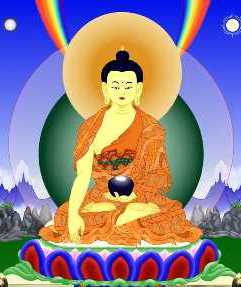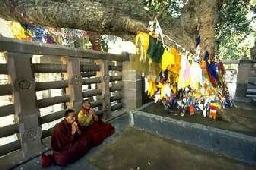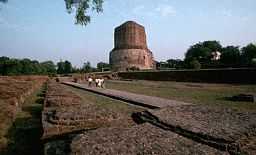
THE BUDDHA
"Enlightenment, for a wave in the ocean,
WHAT IS A BUDDHA?The word Buddha means "awakened one" or "enlightened one". The Buddha was an "ordinary"
human like you and me before he became enlightened. Enlightenment
is compared to waking up, because we suddenly experience a complete
transformation of body and mind when we wake up. A Buddha is a person who has developed all positive
qualities and eliminated all negative qualities. One
could say that a Buddha represents the very peak of evolution, as
he/she is omniscient or all-knowing. With his wisdom, a Buddha really understands the truth, whereas ordinary people live like in a dream, an illusion that prevents us from understanding reality properly.
The historical Buddha, Shakyamuni or Gautama Buddha, lived about 2,500 years ago in India. However, he was not the first Buddha, and will not be the last either. He taught that during this eon (very long time period, maybe comparable to the life-time of the universe as we know it), there would be 1,000 fully enlightened Buddhas who would introduce Buddhism (after it has been totally forgotten). The numbers one to three in this eon are Krakucchanda, Kanakamuni, Kashyapa, then comes Shakyamuni (the historical Buddha some 2,500 years ago), and the next Buddha will be called Maitreya.[1] WHAT IS A BUDDHA NOT?A Buddha is not the creator of the universe, like "God" in the Christian-Judeo-Islamic sense. In fact, there is no creator of the universe given in Buddhist philosophy apart from the karma (actions) of sentient beings (beings with a mind like huans and animals). The Buddha is not omnipotent (all-powerful) like the Christian-Judeo-Islamic "God". (The simple reason is that if he were, out of compassion, he would have long released all sentient beings from suffering.) The state of a Buddha is not impossible to reach (although it may take many lives and extensive effort). A Buddha is not hindered by ignorance, but is omniscient (knows everything). A Buddha is not a passive being; he will use his wisdom to help to other living beings when they are open to his advice. SHAKYAMUNI BUDDHA'S LIFE STORYPrince Siddharta Gautama was born some 2,500 years ago as a prince in what is now called Lumbini in Nepal. At his birth, many special signs appeared. His father asked a sage living in his kingdom for advice on his son. The sage predicted that Gautama would become either a great King or a great spiritual teacher. The King wanted his son to be his successor and tried to keep him far away from all matters of life that could incline him to a spiritual life. Gautama usually spent his life in his father's palace, surrounded by all the possible luxuries of the time. He proved to be a special child, being quite intelligent as well as an excellent sportsman. He married to a beautiful woman he loved, and they had a son. When Gautama was 29 years old, he discovered there was much suffering in the world around him. Traditionally it is explained that he suddenly recognised the problems of sickness, old age and death when visiting the city. Being shocked by the suffering of all living beings, he decided to search for way to end it. He left his wife and child, the palace and even his royal clothes, and started out on a spiritual quest. Gautama studied under various teachers and followed
their practices until he mastered them all. His first teacher was
Alara Kalama who taught a form of meditation leading to an exalted
form of absorption called "the state of no-thingness", a state without
moral or cognitive dimension. Gautama saw this was not going to
solve suffering, and continued his search.
He then sat down in a place now called Bodhgaya (North India) under a Bodhi-tree and decided not to get up anymore until he discovered the truth. Just a short time later, he became a fully enlightened Buddha. This means that he actualised all positive potentials of a sentient being and rid himself of all negative qualities. With this, he realised the true nature of existence and suffering (emptiness), and how suffering can be ended. (On the right is a descendant of the original Bodhi tree in Bodhgaya.) Seven weeks after enlightenment, the Buddha gave his first discourse in Sarnath, near Varanasi (see image below right). Here he taught the 4 Noble Truths. The Buddha continued to teach during his life, until passing away at the age of 81. The Buddha once summarised his entire teachings in one sentence:
The main disciples of the Buddha are also known as the Great Arhants: Shariputra, known for his understanding of the Abidharma teachings; Maudgalyayana, known for his psychic powers; Mahakashyapa, the great ascetic; and Ananda, the personal attendant of the Buddha who recalled every word the Buddha spoke. The Buddha's life is also sometimes summarized in the so called 'Twelve Deeds of the Buddha'. See the Samye website for a description of these. People often wonder if it was not selfish from the Buddha to leave his wife and child, and the rest of his family on his spiritual quest. Of course, on the short-term it may have caused especially his wife much sorrow, however, as is nicely recounted at the Buddha Mind website, all his family members achieved enlightenment. One of the important annual Buddhist festival days celebrates the Buddha's returning from the 'Heaven of the 33'; he went there to teach the devas of that realm, including his mother, so that she achieved enlightenment. So, it is easy to see that whatever suffering the Buddha caused to his family members turned into more then a blessing in the end. ZEN (CH'AN) STORY - LIKE A PILE
OF BULLSH**
|


